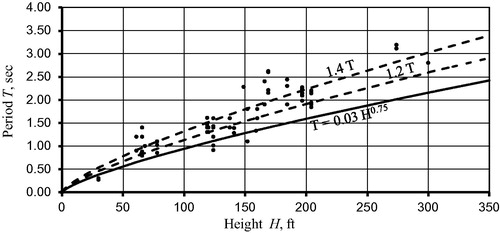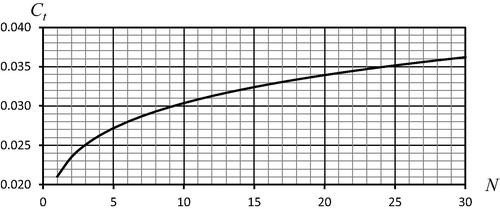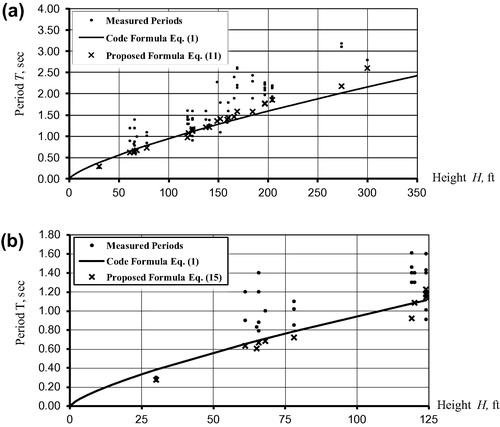 ?Mathematical formulae have been encoded as MathML and are displayed in this HTML version using MathJax in order to improve their display. Uncheck the box to turn MathJax off. This feature requires Javascript. Click on a formula to zoom.
?Mathematical formulae have been encoded as MathML and are displayed in this HTML version using MathJax in order to improve their display. Uncheck the box to turn MathJax off. This feature requires Javascript. Click on a formula to zoom.Abstract
Most seismic design codes generally provide formulas to be used for the estimation of the base shear and lateral loads. For the determination of the lateral loads, it is required to estimate first the fundamental vibration period of the building theoretically or experimentally [1–4].
In various current codes such as the current United States (US) and Egyptian building codes and also in the recommendations of many researches, empirical formulas relate the building fundamental period of vibration (T) to the building overall height (H) or the number of stories (N) without consideration of the two factors together. In this paper, improved formulas for estimating the fundamental period of vibration (T) of reinforced concrete moment-resisting frame buildings are developed by taking the effect of both building height (H) and number of stories together (N) (i.e. take the floor height (h) into consideration). The improved formula is based on regression analysis of the available data for the fundamental vibration period of reinforced concrete moment-resisting frame buildings measured from their motions recorded during eight California earthquakes. The results indicated that the value of coefficient Ct in the current US and Egyptian building codes’ formulas should be modified to be a function of the number of stories (N). Comparisons between the periods determined using the proposed formula and the measured values show good agreement.
Introduction
The fundamental vibration period of a building appears in the equation specified in building codes to calculate the design base shear and lateral forces. Building design codes provide empirical formulas that depend on the building material [steel, reinforced concrete (RC), etc.], building type (frame, shear wall, etc.), and overall dimensions. The fundamental vibration period of buildings have a significant influence on the seismic induced lateral forces.
The period of formulas in the 1997 Uniform Building Code (UBC1997) [Citation1], the 1996 Structural Engineering Association of California (SEAOC) recommendation [Citation2] and the recent Egyptian Code (EGC2012) [Citation3] are derived from those developed in 1975 as part of the ATC3-06 project [Applied Technological Council (ATC) 1978] [Citation4] largely based on periods of buildings measured from their motions recorded during the 1971 San Fernando earthquake. Goel and Chopra [Citation5-Citation[6]Citation7] developed improved empirical formulas to estimate the fundamental vibration period of RC moment resisting frames (MRF) buildings for use in equivalent lateral force analysis specified in building codes using motions of many buildings recorded during earthquakes. Data used in [Citation7] have been combined from the motions of buildings recorded during the 1971 San Fernando, 1984 Morgan Hill, 1986 Mt. Lewis and Palm Spring, 1987 Whitter, 1989 Loma Prieta, 1990 Upland, 1991 Sierra Madre and 1994 Northridge earthquakes.
The objective of this paper is developing improved empirical formulas to estimate the fundamental vibration period of RC MRF buildings as a function in both the building overall height (H) and the number of stories (N) based on data given in [Citation7].
Period database
As the data required for the regression analysis depend on the measurement of the fundamental period during earthquakes, there is a lack of data especially in Egypt.
Data that are used in the regression analysis in this paper are that used by Goel and Chopra [Citation7]. This database contains data for buildings measured from their motions recorded during eight California earthquakes, starting with the 1971 San Fernando earthquake and ending with the 1994 Northridge earthquake.
shows the subset of this data base pertaining 37 data points for 27 RC MRF buildings.
Table 1 Period data for RC MRF buildings [Citation7].
The number of data points exceeds the number of buildings because the period of some buildings was determined from their motions recorded during more than one earthquake or was reported by more than one investigator for the same earthquake.
From these data, it can be noticed that the significant difference of the floor heights where it ranges between 8.45 and 23.8 ft. takes our attention to the effect of the number of stories (N) in the fundamental period of vibration (T).
Code formulas
The empirical formulas for the fundamental vibration period of MRF buildings in most design codes such as U.S. building codes (UBC-97, ATC 1978, SEAOC-96, and NEHRP 1994) and the recent Egyptian code (EGC2012) are of the form(1)
(1) where H = overall height of the building in feet above the base; and Ct is a numerical coefficient related to the lateral-force-resisting system. The values of Ct specified in these codes are: 0.030 and 0.035 for RC and steel MRF buildings, respectively, with one exception: in ATC3-06 recommendations Ct = 0.025 for RC MRF buildings.
In some design codes such as the NEHRP-94 [Citation8] provisions and the earlier versions of other seismic codes as Egyptian code (EGC 1993) [Citation9], an alternative formula for RC MRF buildings(2)
(2) where N = number of stories. The simple formula is restricted to buildings not exceeding 12 stories in height and having a minimum story height of 10 ft.
Most of current codes specify that the design base shear should be calculated from(3)
(3) where W = total seismic dead load; and C = seismic coefficient dependent on the soil profile, seismic zone factor; important factor; the fundamental period T; and the numerical coefficient representative of the inherent over strength and global ductility capacity of the lateral-load-resisting system.
The fundamental period T, calculated using the empirical formulas in Eqs. (Equation1(1)
(1) andEquation2
(2)
(2) ), should be smaller than the true period to obtain a conservative estimate for base shear. Therefore, code formulas are calibrated internationally to underestimate the period by approximately 10–20% at first yield of the building.
The codes permit calculation of the period by a rational analysis [Citation10], such as the Rayleigh’s method, but specify that the resulting value should not be longer than that estimated from the empirical formula by a certain factor.
Evaluations of code formulas
In order to evaluate the code period formulas, the measured building period’s records are compared with those obtained from the empirical code formula (Eq. (Equation1(1)
(1) )) in where they are plotted against the building height (H).
The measured periods are represented by solid circles, whereas code periods are represented by a curve denoted as T. In addition, curves for 1.2T and 1.4T are included representing restrictions on the period from rational analysis imposed by various US and Egyptian codes.
From for all RC MRF buildings, we can observe the following
| - | The code formula leads to periods are generally shorter than measured periods. | ||||
| - | The code formula is close to the lower bound of measured periods for buildings up to 160 ft. high. | ||||
| - | The code formula leads to periods significantly shorter than the measured periods for buildings in the range of 160 – 225 ft. the lower bound tends to be about 1.20 times the code periods. | ||||
| - | Although for concrete MRF buildings taller than 225 ft. data are limited, the code formula would lead to a much shorter period compared to measured periods for such buildings. | ||||
From the previous observations the coefficient Ct = 0.030 in current codes may be too conservative and should be modified to be function of the number of stories (N). The relation between the total height of the building (H) and the number of floors (N) depends on the floor height which is significant difference from one building to another as shown before in .
5 Regression analysis method
From the code formulas and recommended formulas in the recent researches, the suggested formula which is adopted in the present paper is of the form(4)
(4)
in which constants α, β and γ depend on building properties, with γ bounded between one-half and one. This form is adopted in the present paper and constants α, β and γ are determined by regression analysis of the measured period data.
For the purpose of regression analysis, it is useful to recast Eq. (Equation4(4)
(4) ) as
(5)
(5)
in which z = log (T), a = log (α), x = log (N), and y = log (H).
The database given in is used in the regression analysis. These data represent the measured fundamental period of RC MRF buildings (T) and the corresponding number of stories (N) and the overall height (H) for each building.
Using computer software, multiple regression analysis technique is developed for the suggested form Eq. (Equation5(5)
(5) ) to obtain the constants a, β and γ of the plane represented by Eq. (Equation5
(5)
(5) ). Then α was back-calculated from the relation a = log (α). The regression analysis technique depends on minimizing the squared error between the measured and computed periods.
This procedure leads to values of α, β and γ for Eq. (Equation4(4)
(4) ) to represent the best-fit to the measured period data using least-squares method.
The standard error of estimate is(6)
(6) where zi = log (Ti) = observed value (with Ti = measured period); (a + βxi + γyi) = [log (α) + βlog Ni + γ log (Hi)] = computed value of the ith data; and n = total number of data points. The se represents scatter in the data and approaches, for large n, the standard deviation of the measured periods from the best-fit equation.
For code applications, the formula should provide lower values of the period, and this was obtained by lowering the best-fit plane [see Eq. (Equation5(5)
(5) )] by se without changing its slopes. Thus αL, the lower value of α, is computed from
(7)
(7)
This bound implies that only 15.9% of the measured periods would fall below the lower bound plane.
Also, codes specify an upper limit on the period calculated by rational analysis. This limit was obtained by raising the best-fit plane [see Eq. (Equation5(5)
(5) )] by se without changing its slopes. Thus αU, the upper value of α, is computed from
(8)
(8)
This bound implies that only 15.9% of the measured periods would fall upper to the lower bound plane.
Results of regression analysis
The theoretical form of Eq. (Equation4(4)
(4) ) was adopted in the present investigation and constants α and β were considered as variables. This unconstrained regression analysis led to the best possible fit and thus the minimum possible error between the measured and calculated periods (se = 0.204). The obtained formula is
(9)
(9)
In another regression analysis only α and β were considered as variables; γ was fixed at 0.75 [rounded off to the nearest 0.05 of Eq. (Equation9(9)
(9) )] which is in concord with most codes formulas. As expected, this constrained regression analysis led to negligible higher errors (se = 0.204). The adjustment formula is
(10)
(10)
The formula that is of interest for code-type application is the one that provides a lower bound to the measured data, denoted as TL, correspondence to the best fit – 1 σ. The upper limit on the period calculated by rational analysis, denoted as TU, correspondence to the best fit +1σ.
Eqs. (Equation7(7)
(7) andEquation8
(8)
(8) ) was used in the last regression analysis [Eq. (Equation10
(10)
(10) )] to obtain αL=0.021 and αU=0.032 leading to
(11)
(11) and
(12)
(12)
If Eqs. (Equation11(11)
(11) andEquation12
(12)
(12) ) are plotted in 3D graph, very few data fall above the surface represented by TU or below the surface represented by TL. This indicates that Eq. (Equation11
(11)
(11) ) is suitable for estimating, conservatively, the fundamental period and Eq. (Equation12
(12)
(12) ) for limiting the period computed from rational analysis. This period should not be longer than 1.5TL; the factor 1.50 is determined as the ratio 0.032:0.021, rounded-off to one digit after the decimal point.
Eq. (Equation11(11)
(11) ) can be put in the same form of the empirical formulas [Eq. (Equation1
(1)
(1) )] for the fundamental vibration period of RC MRF buildings in most design codes where the coefficient Ct calculated as a function of the number of stories N is given as follows
(13)
(13)
Also, the coefficient Ct can be obtained using the relation curve given in . According to this modified relation the coefficient Ct which equals to 0.030 in the most current codes will be range from 0.025 to 0.036 for number of stories N equals to 3 and 30, respectively.
Using the same procedure that was used in the previous regression, another regression analysis is performed with the data including the total height of the buildings H which were less than 125 ft. only (17 data points). These data represent most Egyptian buildings and the resulting equations may be more suitable for buildings in this range of total heights. The obtained formulas are(14)
(14)
(15)
(15) and
(16)
(16)
Comparisons of the results
Using the data given in for the fundamental vibration period of RC MRF buildings, shows the comparison of the standard error obtained by Eq. (Equation11(11)
(11) ) of the present work, and that suggested by Goel and Chopra [Citation7] with that obtained by the empirical formula used in most design codes [Eq. (Equation1
(1)
(1) )].
Table 2 Comparison of results from regression analysis for RC MRF buildings.
It can be noticed that the improved Eq. (Equation11(11)
(11) ) gives the least standard error which may be used in the design codes.
Also, shows a comparison between the measured building period’s records with those obtained from the proposed Eqs. (Equation11(11)
(11) andEquation15
(15)
(15) ) and those obtained from the empirical code formula (1). This comparison clears that the resulting building periods from the proposed formulas (11), (15) are closer to the measured building periods than those obtained by the empirical formula used in most design codes (1).
According to the subset of data base used in the regression analysis, the improved Eq. (Equation11(11)
(11) ) is valid for buildings with total height H ranging from 30 to 300 ft. (corresponding to number of stories N ranging from 2 to 30 stories) and Eq. (Equation15
(15)
(15) ) may be more accurate for buildings with total height H ranging from 30 to 125 ft. (corresponding to number of stories N ranging from 2 stories to 13 stories).
Conclusions and recommendations
For the determination of periods of vibration of RC MRF buildings, it is necessary to take into consideration the effect of both the building overall length (H) and the number of stories (N) together. Improved formula for estimating the fundamental period of vibration (T) of RC MRF buildings are developed by regression analysis of the measured period data considering the coefficient Ct as a function of the number of stories N.
Based on analysis of the available data for the fundamental vibration period of 27 RC MRF buildings measured from their motions recorded during earthquakes, (11) is recommended for estimating the period of RC MRF buildings. This formula provides the best fit of (4) to the available data. The fit is better than possible equation (1) in most current codes. Furthermore, the period from rational analysis should not be allowed to exceed the value from the recommended equation by a factor larger than 1.5.
Regression analysis that led to the recommended formula should be repeated periodically on larger data sets including buildings in other parts of the world where building design practice is significantly different than California.
Notes
Peer review under responsibility of Housing and Building National Research Center.
References
- Uniform Building Code (UBC-1997), International Conference of Building Officials, Whittier, Calif.
- Structural Engineers Association of California (SEAOC-1996)Recommended Lateral Force Requirements and Commentary, Seismological Committee1996Structural Engineers Association of CaliforniaSan Francisco, Calif.
- Egyptian Code for Computation of Loads and Forces in Structural and Building Work (EGC-2012). Housing and Building Research Center, Cairo, Egypt.
- Applied Technological Council (ATC)Tentative Provisions for the Development of Seismic Regulations for Buildings, Rep. No. ATC3-061978Applied Technological CouncilPalo Alto,Calif.
- R.K.GoelA.K.ChopraEvaluation of Code Formulas for Fundamental Period of Buildings, CD-ROMProc., 11th World Conf. on Earthquake Engrg., Paper No. 11271996Elsevier Science LtdOxford, U.K
- R.K.GoelA.K.ChopraVibration Properties of Buildings during Earthquakes, Rep. to be Published1997Earthquake Engrg. Rs. Ctr., Univ. of CaliforniaBerkeley, Richmond, Calif
- R.K.GoelA.K.ChopraPeriod Formulas for Moment Resisting Frame BuildingsJournal of Struct. Engrg., ASCE12311199714541461
- NEHRPRecommended Provisions for the development of Seismic Regulations for New Buildings1994Building Seismic Safety CouncilWashington, D. C.
- Egyptian Code for Computation of Loads and Forces in Structural and Building Work (EGC-1993). Housing and Building Research Center, Cairo, Egypt.
- A.K.ChopraDynamics of Structures: Theory and Applications to Earthquake Engineering2001Prentice-Hall IncUpper Saddle River, N.J.



